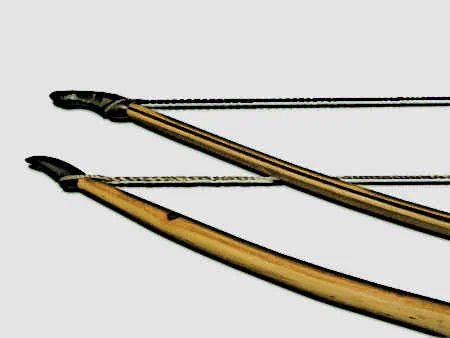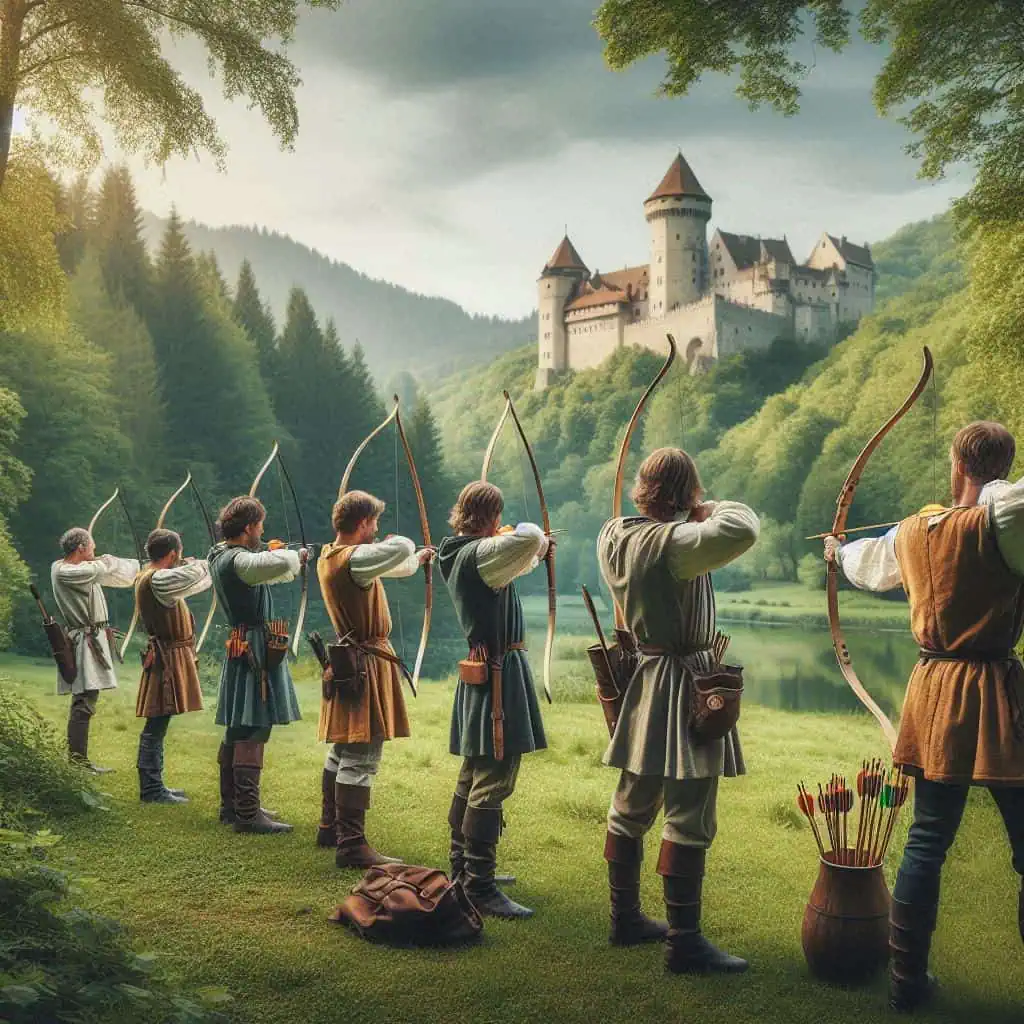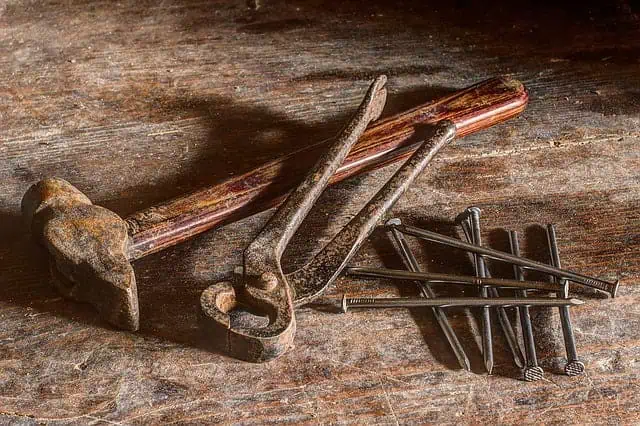Medieval bowyers were essential artisans in the Middle Ages, responsible for crafting the powerful longbows and short bows used in battle, hunting, and sport. These highly skilled craftsmen used woods like yew and ash to create weapons that could decide the outcome of a war. A bowyer’s craft required not only woodworking talent but also a deep understanding of balance, tension, and draw strength. Whether supplying archers for great battles like Agincourt, or working in guild-backed workshops, the medieval bowyer stood as a crucial figure in the military and economic landscape of medieval Europe.

As time progressed these skills became more established and organised and eventually Guilds were set up with rigorous apprenticeships.

Originally longbow-makers (Bowyers) and arrow-makers (Fletchers) were joined together as one organisation.
However in 1372 Fletchers asked for their own organisation to be created, eventually they were given permission to become a seperate entity from bowyers and formed the Worshipful Company of Fletchers In 1429

The medieval bowyer who was among the most in-demand of these medieval craftsmen who made and sold weapons.

In the case of a medieval bowyer, the main weapons made as the name suggests were bows, commonly known as longbows that were made to the same height as the user, so that the bow could be drawn back toward the users chest.

The longbow was an important weapon in Britain, less so in continental Europe where they favoured the crossbow. It was used to devasting effect during the 100 years wars of the Plantagenet period.
Advanced warfare tactics using longbowmen were used at the
- Battle of Crécy 1346
- Battle of Poitiers 1356
- Battle of Agincourt 1415

The crossbow was in high demand in Britain and a skilled Bowyer could produce one quality bow from a strip of yew wood in around two hours.
Bowyer *Training
Just like every other medieval Craftsman, a bower required specific training to become an expert in his profession. The training of a medieval bowyer generally took place under the supervision of an experienced bowyer.

Thus by learning from the expert of the field, a bowyer would become an expert medieval Craftsman himself. In time Guilds and structured apprenticeships were created.

Medieval Bowyer Life
A bowyer spent most of his time in a workshop making bows. Of course, the nature and burden of work would vary from time to time.

During periods of war, a bowyer would be busier than usual. He used a variety of wood
-
-
-
- Ash
- Hickory
- Poplar
- Yew
-
-

-
-
-
- Where did Bowyer Craftsmen Work?
- Tools used by a Medieval Bowyer
- Who bought Goods from a Bowyer Craftsman?
-
-

Where did a Bowyer work
Medieval bowyers were among those medieval Craftsman whose work was quite demanding and they needed dedicated space for their work.
Thus medieval bowyers would work in their workshop which is where they would put their tools and works in progress. It required much expertise to produce bows using different kinds of wood while retaining the flexibility and durability of the weapon.
Bowyer Tools
A medieval bowyer used a variety of tools for the making of Longbows in his workshop
-
-
-
- Axes
- Draw knives
- Chisels
- Toothing planes
- Scrapers
-
-

He used tools to cut the wood into the required shape and hammers for nails whenever required. He also needed different kinds of wood, mostly poplar, ash, yew, or hickory.

A rack was used to bend the bow into the required shape. This also required treating the bow with warm water and steam. Bowstrings were usually made from fibrous plants, animal sinew, or leather strips.

Who Were a Bowyers Customers
The most important customers of a bowyer medieval Craftsman were, of course, the soldiers. Thousands of bows were made every year for the need of the military and this single factor retained the status of bowyers as important medieval Craftsmen.

However, sometimes common people would also require arrows and bows, including the nobility. Thus the customers of medieval bowyers were quite diverse.
Medieval Bowyer Summary
During medieval times, the need for weapons was always high due to constant wars and conflicts. A medieval bowyer who made arrows and bows was thus considered a very important medieval Craftsman.
A Bowyer would make arrows and bows in his workshop through a long and careful process. These weapons were mainly made for the countries military although common people would also buy products from a medieval Bowyer.
- Bowyers were highly skilled craftsmen and part of a Guild
- Bowyers had shops in medieval towns and villages
- Bowyers served long apprenticeships
We hope you enjoyed this article on medieval Bowyers, medieval bowyers were important people in medieval towns and villages, you can find out the other medieval craftsmen that worked in medieval towns, villages, and cities by visiting our medieval craftsmen pages, the links are at the bottom of this page about medieval bowyers.
What was a medieval bowyer?
A medieval bowyer was a specialized craftsman who designed and built bows used by archers in warfare, hunting, and tournaments. Their work required skill in selecting and shaping the right types of wood.
What materials did bowyers use to make bows?
Bowyers primarily used yew, elm, ash, or hazel wood. Yew was the most prized due to its combination of flexibility and strength, ideal for crafting powerful longbows.
How did a bowyer differ from a fletcher?
A bowyer crafted bows, while a fletcher made arrows. Both were essential to supplying medieval archers, often working together to ensure compatibility between arrows and bows.
Where did medieval bowyers work?
Bowyers operated in town workshops, castles, or near military garrisons. Their workspaces needed tools like drawknives, rasps, clamps, and tillering sticks to craft and test bows.
Were bowyers important in medieval warfare?
Absolutely. During wars—especially in England during the Hundred Years’ War—bowyers played a vital role in equipping armies with the deadly longbow, a weapon known for its power and range.
Did bowyers have guilds or apprenticeships?
Yes, bowyers often trained through a guild system, starting as apprentices before becoming masters. The Bowyers’ Company in London, for example, helped regulate quality and training.






